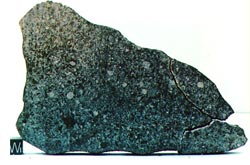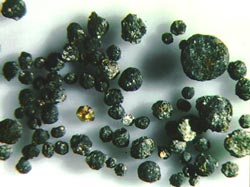Meteorite or Meteorwrong?
By William Case
You found a strange rock. It is heavy, dark-colored, and magnetic; so you are thinking it must be from outer space. You visualize it falling through the air in a blaze and landing right where you are.
Let’s do a reality check. The odds of finding a meteorite are slim even if you see it fall. Most disintegrate before reaching the ground.
Source of Meteorites
Most meteorites on Earth (99.8% of the approximately 34,000 recorded) originally orbited the sun in the asteroid belt located between the orbits of Mars and Jupiter.
Some meteorites found on the earth are rocks knocked off the Moon and Mars by meteoroid impacts. A little over 100 meteorites are considered to be lunar meteorites because their mineralogy, composition, and texture resemble moon rocks collected during the 1969-1972 Apollo moon missions.
A little over 70 meteorites are considered to be Martian meteorites based on their crystallization age range (4.5 billion to 150 million years) and mineral composition. A few of the Martian meteorites contain gases that match the chemical and isotopic composition of the Mars atmosphere measured by the 1976 Viking missions.
| Mineral Groups Found in Meteorites | |||
|---|---|---|---|
| Carbon (including diamonds) | Iron Chromium Oxides | Metallic Iron-Nickel | Aluminum Oxides |
| Iron Sulphides | Iron Carbides | Phosphides | Iron Oxides |
| Pyroxenes | Feldspars | Olivine | |
Classification of Meteorites
There are more than 50 meteorite types grouped into three broad categories: stony, iron, and stony-iron. Stony meteorites are further subdivided into chondrites and achondrites. Utah’s 18 known meteorites comprise 6 iron and 12 stony (11 chondrites and 1 achondrite) meteorites.
Stony meteorites generally resemble dark, heavy, clastic, sedimentary Earth sandstones or conglomerates. Chondrites contain spherical glassy particles called chondrules; achondrites do not. Chondrules may be the oldest material in the Solar System, about 4.5 billion years old, the age of the Solar System. Eighty-two percent of all the meteorites on Earth are chondrites and 7.8 percent are achondrites.
Iron meteorites are some of most distinctive meteorites because they have a metallic appearance, are very heavy, and usually have smooth depressions called regmaglypts on their surface that resemble “thumb prints.”
Stony-iron meteorites are mixtures of metallic iron-nickel and non-metallic materials.
Rarely Found
According to the Meteoritical Bulletin Database of the Meteoritical Society, there have been only 1541 meteorite finds in the United States between 1807 and 2007, and only 91 of those were witnessed falls. These records also indicate that from 1869 to 2004 there were 18 meteorites found in Utah, including one witnessed fall and subsequent find, a rare event.
| Meteorite Finds | |
|---|---|
| Meteorite Type | Percent Found |
| Stony | 89.8% |
| Iron | 4.8% |
| Stony-Iron | 1.2% |
| Others* *volcanic rocks, minerals, from Mars and the Moon, & ? |
4.2% |
How to determine if your rock is worth sending to a chemical lab and a scientist to be verified as a meteorite
Remember a meteorite rule caveat: few rules are without exceptions.
- Does the rock have a fusion crust? A fusion crust forms on the rock surface as it descends through the Earth’s atmosphere. The crust is paper-thin, dark brown to fresh black, and glassy. Don’t remove the crust; if your rock really is a meteorite it is more valuable if it has a fusion crust. Visit The Meteorite Market to see examples of fusion crust.
- Is the rock magnetic? Iron meteorites strongly attract a magnet, stony meteorites have a slight attraction.
- Does the rock have native iron? Native iron is shiny metal bright and looks like untarnished silver when it is exposed. Native iron is extremely rare in natural earth rocks.
- Does the rock have a streak? Test for streak by rubbing the rock on unglazed porcelain such as the back of a tile. If it leaves a streak, it probably isn’t a meteorite unless it has been lying exposed on the Earth’s surface a very long time.Meteoritic iron doesn’t have much of a streak because it isn’t exposed to oxygen until reaching the Earth. In contrast, Earth minerals composed of iron oxide have streaks; hematite has a red-brown streak and magnetite has a gray-black streak. Visit http://meteorite-identification.com/streak.html.
- Does the rock feel heavy compared to other rocks about the same size? Stony meteorites usually have a density (g/cm3, oz/in3) from 3 to 4 times the density of fresh water (1 g/cm3, 0.6 oz/in3), stony-iron meteorite density is 4 to 5 times greater than fresh water, and iron meteorite density is 7 to 8 times greater than fresh water.To determine the density of the rock, first determine its volume by placing it in a calibrated (cm3, in3) container filled with water. The volume change of the water is the volume of the rock. Then weigh the rock with a scale (grams, ounces). The approximate density of the rock is its weight divided by its volume. Visit https://sites.wustl.edu/meteoritesite/items/density-specific-gravity/.
- Does your rock have bubble holes (vesicles)? Most meteorites don’t have vesicles.
- The last test is you. If you refuse to:
- give your name to researchers,
- indicate where you found or “obtained” the rock,
- pay lab fees to determine the composition of your rock,
- let scientists destructively test a representative piece of your rock,
- give a small piece of your rock to scientists willing to spend their precious time for testing,
-then the rock is unlikely to be verified as a real meteorite.
- For more “meteorwrongs” information, tests, and images visit Dr. Korotev’s “meteorite realities” web page.
If you and your rock have passed all tests, the next step is to contact someone to do the verification. Go to the following sites for verification procedures:
- More Meteorite Information, Randy Korotev, Washington University, St. Louis, MO
- A Comprehensive Guide to Meteorite Identification, Geofrey Notkin, Aerolite Meteorites, Tucson, AZ
- Do I have a meteorite?, Center for Meteorite Studies, Arizona State University
- Meteorite Testing and Classifying Institutions, meteorite-identification.com







